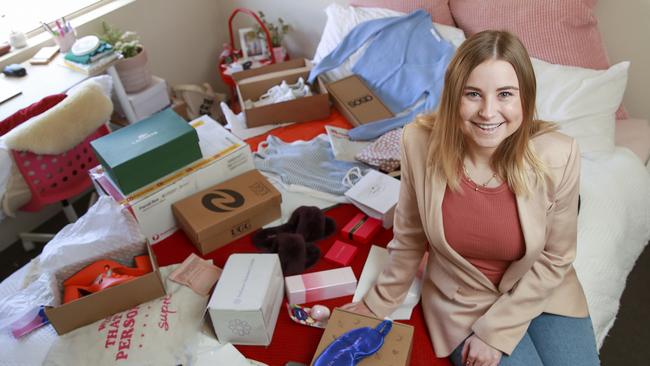The dangers of buy now pay later schemes
Millions of Australians have signed up to buy now pay later schemes while many ditch credit cards, but there are some pitfalls that could lead you to financial distress.
Business
Don't miss out on the headlines from Business. Followed categories will be added to My News.
Buy now pay later schemes continue to boom as tens of thousands of customers sign up to the popular payment services every week.
Afterpay, Zip Pay, Openpay and Humm are among the most-used schemes shoppers are able to use to get their goods months before they pay for them in full.
And the heat is on the banks who are trying to push their way into the booming sector – both the National Australia Bank and Commonwealth Bank announced the rollout of interest-free credit cards in recent weeks.
But experts have warned signing up to credit products should be done with extreme caution.
CREDIT CARD DECLINE
During the pandemic nearly 500,000 credit card accounts in Australia have been shut down.
In July alone Australians wiped a massive $1.9 billion off their balances bringing their total debt down to $34.4 billion – the lowest level since 2006.
Most credit cards attract hefty interest rates – often north of 20 per cent – which can lead customers falling into financial quicksand if they fail to pay off their balances in full each month.
But in recent years customers have turned to BNPL schemes where no interest charges apply, however hefty fees are incurred if the strict repayment criteria is not met each month.
Latest figures from Afterpay showed in last quarter of the 2019/20 financial year 20,500 shoppers signed up a day in both Australia and overseas.
In Australia Afterpay now has 3.3 million active customers while rival Zip Co has 2.1 million customers.
CUSTOMER USAGE
Typically younger Australians use Afterpay and Zip Pay – the average user age for both schemes is 34.
The average purchase amount for Afterpay is $153.
Customer service officer Rebecca Strickland, 26, from Dulwich Hill in Sydney’s southwest signed up to Afterpay in 2017 and since then has made 65 transactions totalling $7600.
She said she used it as a “budgeting tool” to buy presents and clothes.
“It’s better than a credit card because it lets me split up my payments over my payday because I get paid fortnightly,” Ms Strickland said.
“I find it helps me but I have had an instance where I lost my job during COVID.
“I wasn’t able to make the payments so I had to call on my parents to help me meet the repayments.”

Strickland said she had a few hundred dollars owing but she’ll continue to use the schemes to buy items.
Afterpay’s head of operations Mel Bull said their users mostly buy items in categories including home, fitness, office, beauty and cosmetics, apparel, footwear and health.
DANGERS OF SCHEMES/CREDIT CARDS
Buy now pay later schemes are not regulated credit providers which experts say can cause issues for consumers.
The Consumer Action Law Centre’s chief executive officer Gerard Brody said this means it leaves consumers unprotected.
“There’s no requirement checks (by the schemes) to make sure consumers don’t become over indebted and when people become stressed out over those repayments they can go into a spiral,” he said.
“We see lots of people with debts to buy now pay later and it’s often on top of debts to banks, other lenders and payday lenders.”
Mr Brody said this is an important change that needed to be implemented.
“They are provided by a bank that has to get a licence by ASIC and it’s required to meet standards and responsible lending, compared to buy now pay later where the risks are going to be higher,” he said.
Afterpay’s Ms Bull said if users cannot meet their repayments they will be unable to continue to use the scheme.
“If you do not make repayments we suspend your account,” she said.
“Afterpay does not impact a person’s credit file.”
She believes BNPL schemes are a better option for customers than credit cards.
“They rely on consumers making minimum repayments, charging high levels of interest and keeping customers in long-term debt,” Ms Bull said.
“Our in-built protections including pausing a customer’s spending if they are behind in repayments and never charging interest mean we are a much safer alternative.”
INTEREST-FREE CREDIT CARDS
In September both NAB and CBA announced the arrival of new interest-free credit cards in a bid to take on the buy now pay later sector.
NAB’s StraightUp cards has no interest, no late payment fees, no currency conversion fees and a card limit of $3000.
It does have a monthly fee of between $10 and $20 depending on the customer’s chosen credit limit, but the fee is refundable if the customer doesn’t use the card within the month and has a zero balance.
It’s available on the market now.

Following NAB’s announcement rival lender CBA revealed its new Neo card which gives customers up to $3000 of credit, with no interest charges, late payments or foreign currency conversion fees, but customers are charged a monthly fee.
This depends on the card limit of $1000, $2000 or $3000 – the applicable fees are $12, $18 and $22 respectively, but the fee isn’t charged if no purchases are made within the month and the card balance is zero.
The card will be available later this year.
Mr Brody said while it was a “simpler” offering for customers both cards come with challenges.
“If you don’t use the card very much to the full limit then it might not be a very good deal and it could turn out to be quite expensive,” he said.
“That’s probably not very clear to the borrowers.”
USE OF CREDIT
Mr Brody said consumers who do use credit products should check if they actually need the item they are purchasing.
“People should really question whether they need to buy something on credit, it can be helpful when you are buying a big item like a car or something that is going to help you over the long term,” he said.
“Using credit for everyday needs can be a recipe for disaster, you are probably much better off trying to save and have a safety net fund that they can call on in emergencies.”
He said lenders profit by making borrowers manage their money week to week.
AFTERPAY
• Four fortnightly repayments.
• No interest charges.
• If a payment is not met in time late fees apply.
• A $10 charge is the first late fee followed by a $7 fee if the payment is unpaid 7 days later.
• Fees are capped at 25 per cent of the original purchase price or $68, whichever is less.
• Users cannot use the scheme if they miss a payment.
.ZIP PAY
• Limit of $1000.
• No interest charges.
• No fees are charged in the first billing cycle.
• Minimum repayments from $40 per month.
• $6 monthly fee. This is waived if there is no balance.
• A late fee of $5 may be charged if no payments are made for 21 days.
Originally published as The dangers of buy now pay later schemes

